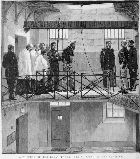Multimedia Content

Ned Kelly on the scaffold in the Old Melbourne Gaol, 20 November 1880, courtesy of State Library of Victoria.
Details
Old Melbourne Gaol
Built in Russell Street in the mid-19th century as a short-term remand prison, and closed in 1929, the old Melbourne Gaol now exerts an uneasy fascination for tourists and school excursion groups.
Construction on the extant three-storey, bluestone cell block started in 1853. The women's cell block, walls and other buildings were demolished in the 1930s. The complex reopened briefly during World War II as a military detention compound where soldiers who had been absent without leave, drunk and disorderly or incorrectly dressed could be detained. The chapel, front gates and administration section remain and are used by RMIT University.
This gaol, and others such as Pentridge and Geelong, were based on Joshua Webb's Pentonville Prison design. The building and the rules governing the prisoners were designed to reform the inmates. Hardened criminals who had committed serious crimes of murder, arson, burglary, rape and shooting were held in solitary confinement in single cells on the ground floor. The next level up had slightly larger cells where two or more prisoners were held. These prisoners had to wear calico hoods when outside their cells and a rule of silence was strictly enforced, adding to their isolation. Towards the end of their sentence their isolation was broken and they were allowed to mix with other prisoners. Corporal punishment was inflicted for breaking the prison rules or regulations. The large, top-floor cells held up to six prisoners who had committed minor crimes such as drunkenness, vagrancy, prostitution or petty theft. Male prisoners were expected to work in stone quarries, on buildings and breaking rocks, while women sewed, cleaned and cooked. There was often overcrowding and conditions deteriorated.
The Gaol features a number of death masks, once used for the phrenological study of hanged felons. While capital punishment was still in force in Victoria, 136 hangings took place at the Gaol. The most infamous prisoners were Frederick Deeming and bushranger Edward 'Ned' Kelly. Kelly was hanged on 11 November 1880 and his armour and death mask are displayed in the Gaol. The National Trust listed the building on its heritage register in 1957, and in 1970 reopened it as a penal museum.
